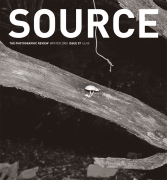Correct Behaviour
Iranian Photography Now – Rose Issa
Book Review by Mary Warner Marien
Issue 57 Winter 2008
View Contents ▸
Iranian Photography Now by Rose Issa
Published by: Hatje Cantz
ISBN: 978-3775722575
Price: £30.00
One of the minor paradoxes in American/Iranian relations is that Iranian films have found a niche market here. The cultural and religious values that constrain the scope of Iranian expression often make that country’s films refined and visually captivating family fare. We have treacly stories about puppies lost and found, food fights, and fart jokes. The Iranians offer movies like The Color Paradise (Magid Magidi, 1999) and The White Balloon (Jafar Panahi, 1995).
With some important exceptions, such as Magnum photographer Abbas and Iranian-American artist Shirin Neshat, Iran’s photographers are less well known than its cinematographers. Filmmakers who also create photographs, such as Abbas Kiarostami, who also wrote the script for The White Balloon, and Mitra Tabrizian, are recognized more for their moving than still pictures.
In Iranian Photography Now, Rose Issa, an artist who works in many media, has wisely showcased an array of contemporary image-makers that ranges from those who work exclusively in photography to those who practice other means of expression. Likewise, the book provides glimpses of photography created by Iranians who live outside the country as well as those who reside there.
Among the latter is Mehran Afshar-Naderi, a documentarian whose work extends from interpreting the decline of neighborhood bathhouses to picturing the life of Afghan refugees in Iran – a topic also taken up in Magidi’s 2001 film, BaranIranian Photography Now, Vosoughnia becomes a photographer of photographs. Visiting family burial chambers in his home city of Qazvin, he dwells on memorial photographs and other artifacts. At the same time, Vosoughnia draws back from his subject, creating a distance that seems to imply not only respect for the privacy of the bereaved, but also to deny the camera the authority to define the deceased. From the series Bodyless, Tehran, Iran (2004) - Mehraneh Atashi
From the series Bodyless, Tehran, Iran (2004) - Mehraneh Atashi
The choice of Tehran native Mehraneh Atashi’s series, Bodyless raises more questions than it answers. Atashi is an adventurous image-maker who does not shy from pointing her camera at activities that officially do not occur in Iran. For Bodyless she posed men who practice a form of body-building linked to poetry and spirituality. She was careful to include her act of taking the photographs in each of the images, knowing, as she puts it in her personal statement, that tradition forbids "the breath of women" in the gymnasium. How Atashi managed to convince the body-builders to allow her to photograph them, and what, if any, local repercussions occurred, are not mentioned in the book.
In her other work, Atashi seems determined to record activities that taunt standards of correct behaviour. She has photographed underground bands and casual meeting spots where young women sometimes let too many strands of bleached blond hair escape from their head coverings. One wonders if her pictures, which like those of many other Iranian photographers can easily be found on the Internet, have been subject to censorship or whether they are allowed to be circulated as a way to distract young men and women from becoming more politically engaged. None of the pictures in Iranian Photography Now allude to the behaviors studied in Pardis Mahdavi’s new book, Passionate Uprisings: Iran’s Sexual Revolution (Stanford University Press, 2008). Dr. Mahdavi’s study describes the increase in casual sexual encounters among well-off heterosexual Tehrani. It’s the Swinging Sixties, without sexual education or condoms, but with capital punishment prescribed for female adulterers.
Tehran’s underground life is also the subject of Amirali Ghasemi’s much discussed Party series, in which young men and women are shown dancing and socializing. More correctly, only part of each figure is shown: the clothed part. Bare hands, arms, heads, and legs have been turned into blank white silhouettes to conceal the partygoer’s identity. The result is an unsettling tension between the colour and three-dimensionality of the settings, and the flat, cardboard cut-out figures. Ghasemi, a graphic designer, who also creates installations, videos, and photographs, founded Tehran’s Parkingallery in 1998, and has kept it focused on emergent artists. Other than Ghasemi, none of the artists in the Parkingallery stable appear in Iranian Photography Now even though some of them, like Iranian-American artist Shadi Yousefian, have achieved notice for their photographs and photo-based work. From the series Party, Tehran, Iran (2005) - Amirali Ghasemi
From the series Party, Tehran, Iran (2005) - Amirali Ghasemi
Iranian Photography Now is a good book that would be a better book if its brief prefacing essay had been expanded to offer more contexts and analysis. For example, Issa notes her difficulty in choosing the 36 photographers for the book, but does not share what criteria she finally used to make her decisions. The historical sections are brief, and the 1990s are covered only in relation to cinema, inarguably a vital subject, but not the only one. The digitization of photography, which provides easy and international distribution as well as sophisticated editing features, is probably the equal of cinematic experience for those born since the Revolution in 1979. The importance of the Internet to Iranian photographers is not discussed, although the section on recommended reading concludes with several useful websites, one of which offered to enter me in the green-card lottery!
On the other hand, Issa’s synoptic list of major themes in contemporary Iranian photography enriches the experience of the photographs. She points out how the legacy of the Iran-Iraq War (1980-1988) suffuses image-making, and how living outside of Iran may of being incessantly perceived as a vaguely sinister Middle Easterner. In sum, as Homi Bhabha points out in his short foreword, the diversity of expression found in this book jolts our expectations.
Other articles by Mary Warner Marien:
Other articles on photography from the 'Multi-Genre' category ▸





